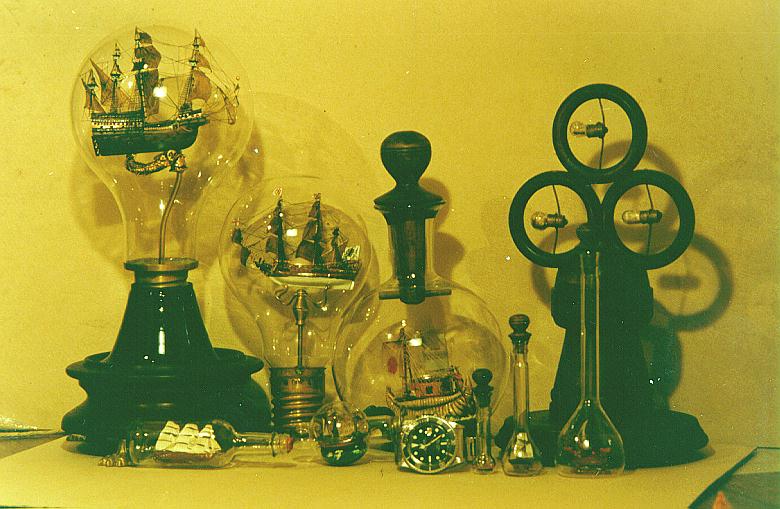
Eddy's Thimble SIB Pier

This page is dedicated to all Ships-in-Bottles's builders, and to lovers of this expression of art and craftmanship.
Since 1988, I have been working on a project named NAVIS IN VITRO (c) , (latin for 'ships inside glass') with the objective of further investigating techniques, putting together a sort of summary of relevant models throughout the world. Besides being an active model builder myself, I am also writing a book capturing the flavour of the bottled seamanship.
Let's share the preface:
The Soul of the Seaman, soul of the Art:
1860. The clipper is making it back to its home port, laden with tea and other valuable goods. Captain has ordered all sails set , even the topgallants, cause he is racing against other clippers for a record breaking delivery time.
Now, the wind blows every moment harder, but the Captain won' t cut sail. First white caps, then full briny spray. Thunderous waves begin breaking against the beakhead. Splashing waters sweep the deck spurting through the lee gunwale troughs. The rigging howls, sinister creacking from mast and yards chills the soul...
Peter is standing watch by the main mast. The main sail starboard braces are his responsibility. Under the murderous gusts he holds fast to the tackle board, drenched to the bones, eyes red and aching from the salt spray, hands cut to the flesh by soaked ropes, body about to give up...
Suddenly, the pressure is just to much for the ship, she lists heavily to port, rudder practically torn from the pintles, wheel escapes the hands of the helmsman. She is about to capsize, taking the waves by the broadside.
Fly the braces!! shouts the boatswain to Peter. Still clinging to the tackle board he desperately tries to set the braces free but he can't. He will cut them, but no axe is there. In horror he finds out his knive too is gone. He still pulls in despair, but only a silent prayer fills his mind.
Then, with an ominous crack the main yard breaks, braces swish by, pressure is released, the hull slowly sets back to its keel. They make it onwards
Next morning, Peter is off duty, strolling down the deck. Everything seems normal on board, storm has ceased, a spare arm is being fitted. He picks up a splinter of wood of the old yard. While holding it a shiver runs along his spine. He vividly recalls the near sinking of the ship, the miracle.
Body aching, he gets back to the f'csle deck. He thinks of a thanksgiving gift to put at the city's chapel.
That afternoon, Peter is carving a small model of the clipper out of the splinter. An empty bottle is waiting at his side...
(excerpt from Navis in Vitro. The Art of Building Ships in Bottles (c) E.Raffaelli)
To SIB, or not to SIB
As you know, a Ship in Bottle is a miniature reproduction of a sailing vessel, inside a bottle.
Save for some exceptions, the so called SIBs (ships- in- bottles) are among the smallest models of ships, since they must fit inside a bottle.
Normally these would be 1 litre or 3/4 ltr hard liquor bottles available to sailors, perhaps even pocket flasks.
But, how small is small for a SIB?
I invite you to take a look at this small collection of really tiny SIBs, constructed mostly inside small light bulbs or very small laboratory flasks.
At this point I think a little explanation would come in handy. These models are not SIBs in the conventional way, that is 'pull thread' models. I also build models this way. But, what's the limit for building SIB's?
These models, which I have been building since the 70's, are more related to the original monks miniatures called Geduldsflaschen ( normally, Closter works in Europe, specially Germany), which today are believed to be the true ancestors of the art.
Construction:
Wood and cardboard for the hulls, rigging made from wood splinters, wires very thin threads and hairs. No pulling threads are used. Therefore, the ship is entirely rigged from the outside of the bottle, part by part, hair by hair.
Normally, scales range from 1:2000 onwards. Bigger scales are also possible, but I believe no bigger than, let's say 1:1000 for a carrack. This is so because on larger scales, threads and conventional rigging and materials are best suited.
Para leer esta introducción en español, ir Al Rincón del BEB
Please, if you would like to see some models, head towards the photo gallery.
Back to Eddy's Thimble SIB Pier
(c) 1998-2020 Eduardo Raffaelli. Buenos Aires . Argentina